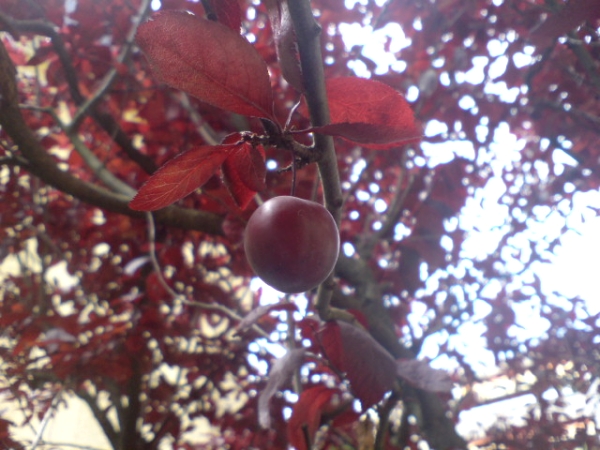Pliss "Pissardi" is distinguished by its unusual appearance and is a decoration of any garden. Many landscape designers use this tree in their compositions.
Given the characteristics of flowering, it will delight their owners almost all year round.
Table of contents
Description of the ornamental varieties of plum Pissardi
Pissardi red leaf plum was bred in Iran, a scientist brought it to Europe, in whose honor the variety was named.This tree is more related to ornamental crops, and not to fruit and berry. Its height can be from 5 to 7 meters.
The shape of the leaves is ovoid, and their length is 5-7 cm. The trunk of the tree and its main branches are painted black or gray-silver.
The first buds of a gentle, pink shade appear as early as April, even before flowering, thus decorating the garden. Then white flowers begin to bloom, from which fruits are subsequently formed.
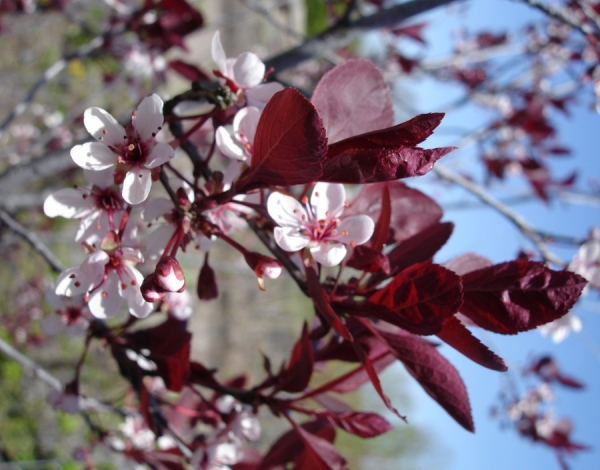
Pissardi can grow in temperate regionsIt is also possible to grow in arid areas. Plum does not tolerate a surplus of moisture, so the southern region, located near the sea is unlikely to fit this variety.
It is also worth considering frost resistance, the tree cannot tolerate too cold temperatures.
Fruits of this variety abundantly cover the entire crown and are decorative. Small, dark red and round, they do not differ outstanding taste.
Merits:
- an unusual appearance and early flowering period make the Pissardi plum a garden decoration almost all year round;
- this variety can be grown even in places with a strong gas pollution of the air and arid climate;
- the tree is unpretentious in leaving and does not demand special attention to itself;
- high resistance to most diseases.
disadvantages:
- low frost resistance does not allow growing such a drain in cold regions;
- the tree is afraid of sharp winds;
- fruits are decorative and do not differ in special taste;
- Pissardi requires a lot of space and does not tolerate close proximity with other plants.
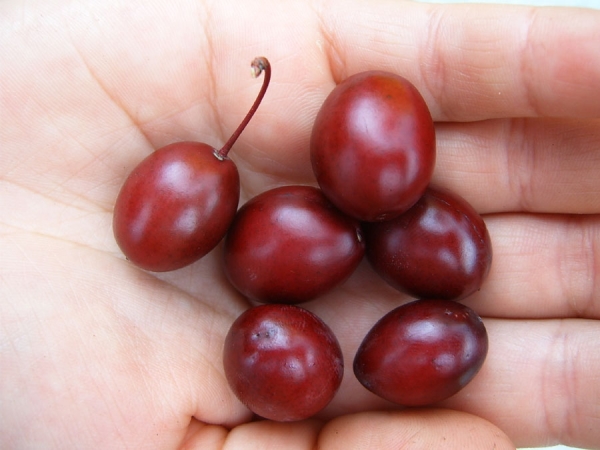
Natural growth region and cultivation features in other regions
Under natural conditions, Pissardi plum grows in Western Asia and the North Caucasus. Such a tree prefers open, sunny frosts and is not resistant to frosty winds.
That is why before purchasing a sapling of this variety, you should think about the place of its cultivation. Cold temperatures, lack of sunlight and a harsh wind can ruin a sapling.
Also she is perfectly able to settle down in an urban areadespite the pollution of the environment.
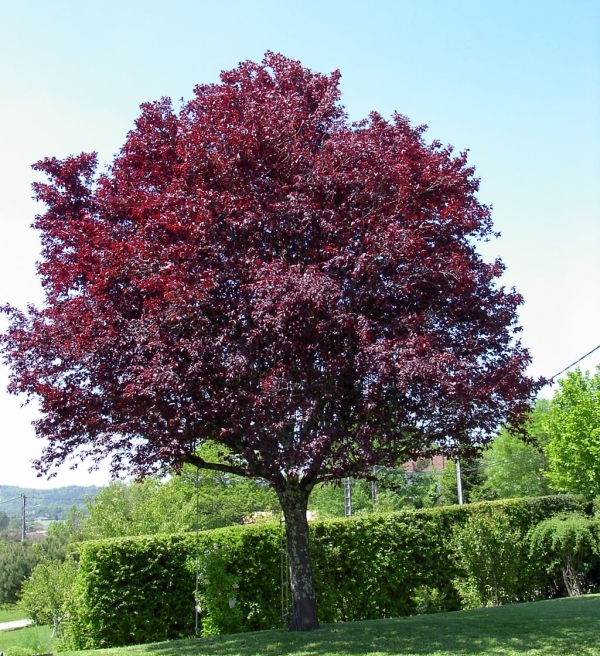
Planting rules for seedlings
Plum can be planted in the fall, before the onset of frost, around mid-September, so in spring, until the kidneys begin to swell, it usually happens in April.
To choose a place for a tree, need to pay attention to the following factors:
- The site should be well littherefore, it is better to plant Pissardi on the south side of all other trees. This is necessary so that they do not shade the plant.
- Also, the variety loves space.
- The soil should be fertile and loose.and the groundwater level should be at least one and a half meters. Otherwise, at the bottom of the pit will have to do drainage of expanded clay or other available tools.
- The main factor will be gust protection, because it is this natural phenomenon that can completely destroy a young tree.
- This variety can be grown both in household plots and within the city.
- Trees are planted at a distance of 2 meters from each other.
- The pit needs to be prepared in advance, about 2 weeks before planting, the foundation pit is pulled out, a depth of 50 and a width of 70 centimeters, a fertile layer of soil mixed with humus is poured into it, and a planting stake is set.
- The seedling must be on the north side of the stick.
- During planting you need to put a tree in a hole so so that the root neck is 3-5 centimeters from ground level and gently sprinkle the root system with fertile soil. As work progresses, the ground is slightly tamped down.
- Once the plum is planted, it is tied to a peg, mulched and watered thoroughly.
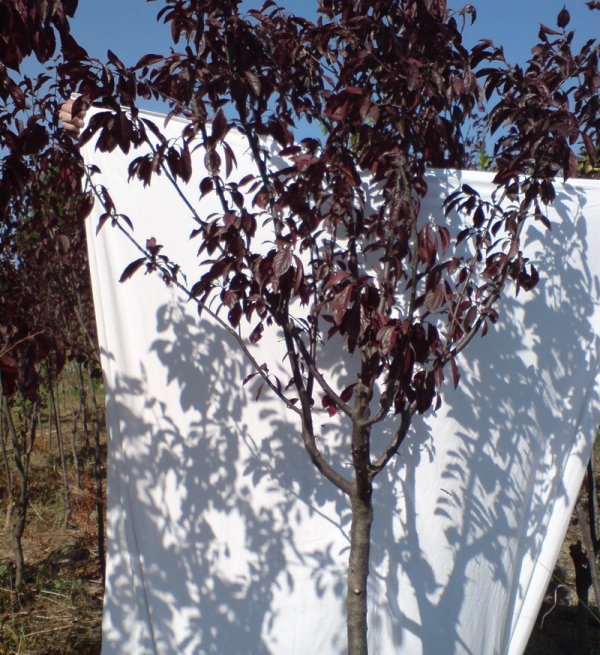
Care rules
Although plum can grow in arid regions, she needs regular and abundant watering. Once every two weeks 4-6 buckets of water are used up per tree.
In the process of its implementation, all dry and damaged branches are removed, as well as excess growth that prevents the penetration of sunlight.
Also need to remove weeds around a tree trunk and timely loosen the soil, so that the roots could get oxygen.
In the first year of life, the plum is not fertilized.. Starting from the second year, the following dressings should be applied:
- in the autumn - humus, one square meter of land half a bucket of fertilizer;
- in the spring use potassium fertilizer or sodium humate;
- to make the plums ripen better during fruiting additional fertilizing is made from urea.
Considering that Pissardi is a heat-loving variety, it needs to be prepared for winter. To do this, the tree is carefully watered, mulched and additionally sprinkled the tree trunk with peat or straw.
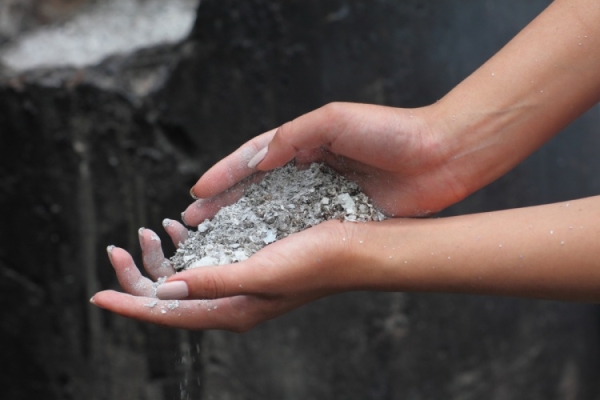
Reproduction of red plum
This fruit and berry culture multiplies in four ways.
With the help of seeds:
- The most healthy and large seeds are selected, which are cleaned of pulp and soaked for 4 days, while they need to be stirred periodically and changed water.
- They are then stored in a dry glass jar.
- The next step will be stratification, during this procedure, the seeds are mixed with wet sand or sawdust and stored in this state for 160-180 days at a temperature not lower than 0 and not higher than 10 degrees.
- Then the seeds are planted in open ground, most often for this procedure is chosen the end of autumn or mid-spring. Deepen such planting material by 70 cm.
Root growth - In the autumn period, it is necessary to chop the root, which will connect the mother plant with the process. In the spring, the resulting seedling is dug and moved to a new location.
Root cuttings - In the fall, you need to dig up the roots with a thickness of 1.5 centimeters and a length of 15 centimeters, at a distance of about 1 meter from a young tree and 1.5 meters from an adult plant.
Store them either in a dug shallow trench (50 centimeters), sprinkled with peat and river sand, or in the basement under a mixture of moss and sawdust.

In early May, the cuttings are transplanted into the greenhouse.A special soil is used, consisting of one part of sand and three parts of peat. Next, you need to deepen the upper ends of 2 cm and zamulchirovat them with sawdust.
To make the cuttings comfortable, they should be slightly shaded. If several shoots go back, then choose the strongest of them.
The plants are fertilized several times per season. slurry, chicken droppings or other organic fertilizers.
Air layouts, red plum:
Diseases and pests
Plum Pissardi variety highly resistant to various diseases and the appearance of pests. The greatest danger to the tree are:
- powdery mildew;
- necrosis of the trunk and main branches;
- green moth;
- fruit cap moth.
There are many drugs that can help get rid of a particular disease. But one should note the most important rule: all damaged parts of the tree must be cut and burned.
For the prevention of diseases need to carry out the following processing:
- To scare off pests in the spring, the crown of the tree is sprayed with insecticides, which include: Aktara, Enzhio, Aktellik.
- To combat the May Khrushcha larva, in mid-April, the tree is treated with Prestige, Anti-Khrusch, etc. In this part of the solution should fall on the trunk, protecting the bark about 10 cm above ground level. This spraying is repeated every 40-50 days.
- Processing with fungicides during the vegetative period is also used.
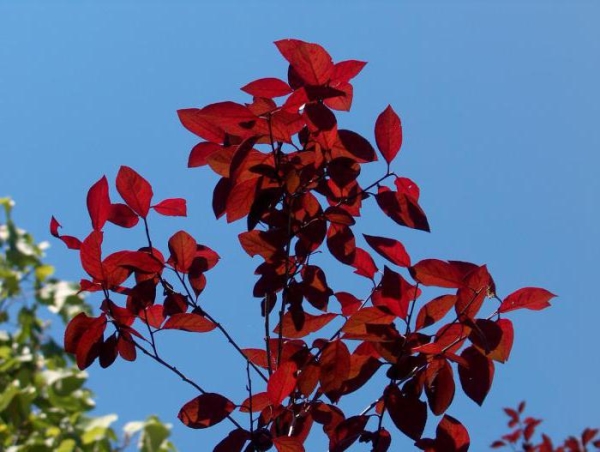
When working with chemicals, you must use personal protective equipment.
Although the Pissardi plum is not distinguished by tasty and juicy fruits, its appearance compensates for the majority of defects. A bright, purple rounded crown will stand out advantageously against other plants.
Plum Purple Pissardii:
